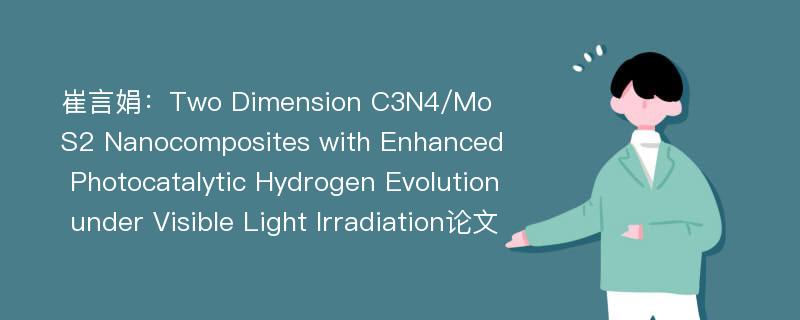
本文主要研究内容
作者崔言娟(2019)在《Two Dimension C3N4/MoS2 Nanocomposites with Enhanced Photocatalytic Hydrogen Evolution under Visible Light Irradiation》一文中研究指出:MoS2-decorated C3N4(C3N4/MoS2) nanosheets hybrid photocatalysts were prepared by a simple sonication-impregnation method. Face-to-face lamellar heterojunctions were well established between two dimension(2D) C3N4 and MoS2 nanosheets. The effects of MoS2 content on the light absorption, charge transfer and photocatalytic activity of the hybrid samples were investigated. Characterization results show that MoS2 nanosheets are well anchored on the face of C3N4 nanosheets and the composites have well dispersed layered morphology. After loading with MoS2, the light absorption of composites was much improved, especially in visible-light region. The photocatalytic activities of C3N4/MoS2 samples were evaluated based on the H2 evolution under visible light irradiation(λ > 400 nm). When the loading amount of MoS2 was increased to 5 wt%, the highest H2 evolution rate(274 μmol·g-1·h-1) was obtained. Compared with samples obtained from direct impregnation method, sonication pretreatment is favorable for the formation of 2D layered heterojuctions and thus improve the photocatalytic activity. Slightly deactivation of C3N4/MoS2 composites could be observed when recycled due to the mild photocorrosion of MoS2. Based on the band alignments of C3N4 and MoS2, a possible photocatalytic mechanism was discussed, where MoS2 could efficiently promote the separation of the photogenerated carriers of C3N4.
Abstract
MoS2-decorated C3N4(C3N4/MoS2) nanosheets hybrid photocatalysts were prepared by a simple sonication-impregnation method. Face-to-face lamellar heterojunctions were well established between two dimension(2D) C3N4 and MoS2 nanosheets. The effects of MoS2 content on the light absorption, charge transfer and photocatalytic activity of the hybrid samples were investigated. Characterization results show that MoS2 nanosheets are well anchored on the face of C3N4 nanosheets and the composites have well dispersed layered morphology. After loading with MoS2, the light absorption of composites was much improved, especially in visible-light region. The photocatalytic activities of C3N4/MoS2 samples were evaluated based on the H2 evolution under visible light irradiation(λ > 400 nm). When the loading amount of MoS2 was increased to 5 wt%, the highest H2 evolution rate(274 μmol·g-1·h-1) was obtained. Compared with samples obtained from direct impregnation method, sonication pretreatment is favorable for the formation of 2D layered heterojuctions and thus improve the photocatalytic activity. Slightly deactivation of C3N4/MoS2 composites could be observed when recycled due to the mild photocorrosion of MoS2. Based on the band alignments of C3N4 and MoS2, a possible photocatalytic mechanism was discussed, where MoS2 could efficiently promote the separation of the photogenerated carriers of C3N4.
论文参考文献
论文详细介绍
论文作者分别是来自Journal of Wuhan University of Technology(Materials Science)的崔言娟,发表于刊物Journal of Wuhan University of Technology(Materials Science)2019年01期论文,是一篇关于,Journal of Wuhan University of Technology(Materials Science)2019年01期论文的文章。本文可供学术参考使用,各位学者可以免费参考阅读下载,文章观点不代表本站观点,资料来自Journal of Wuhan University of Technology(Materials Science)2019年01期论文网站,若本站收录的文献无意侵犯了您的著作版权,请联系我们删除。
标签:Journal of Wuhan University of Technology(Materials Science)2019年01期论文;
